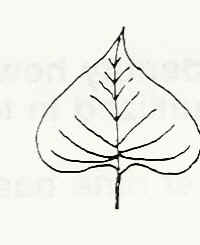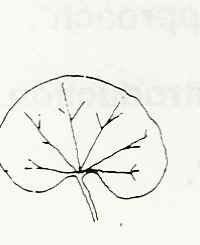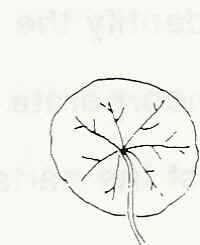
LESSON: The Introduction
COMPETENCIES:
To utilize student needs and experience in developing instructional
materials.
To apply interest techniques to motivate students.
To develop and deliver the introduction to a lesson.
OBJECTIVES:
1. To identify how student background and experience are utilized in lesson
planning.
2. To list nine basic interest development skills.
3. To identify skills useful for controlling interest and securing retention.
4. To develop the "need'. component of a lesson plan
5. To identify the use of the "interest approach".
6. To incorporate the "need" into the introduction.
7. To list the parts of the "introduction".
LEAF SHAPES


ROUND
OVAL


ELLIPTICAL
CORDATE


RENIFORM
PELTATE

LEAF SHAPES
ROUND
OVAL
ELLIPTICAL
CORDATE
RENIFORM
PELTATE

Arousing and Holding Student Interest
1. Begin each day's discussion by connecting the new work
quickly and clearly with previous days work. This can be effectively
accomplished by reviewing the conclusions derived from previous days discussion.
2. Be interested. Call upon interested students early in the
discussion. There is a direct correlation between student interest and interest
of the teacher.
3. Keep pupils thinking. Maintain suspense as to the
conclusions or decisions until all relevant facts have been identified. The
value of appropriate reference materials cannot be over-emphasized.
4. Keep students conscious of the future usefulness and value
of the day's discussion by
(a) using problems and situations they will meet in later life;
(b) encouraging them to discover for themselves the uses they will probably have
for new knowledge in the future and
(c) pointing out to the student the future value of the conclusions reached.
5. Take advantage of every opportunity
a. To appeal
to or involve the natural impulses during the discussion
b. To connect
the thought with interesting things students have already
studied; experienced; plan to experience in the future; past events; and
personal examples and illustrations
c. To
strengthen their sense of progress toward students chosen goals
d. To
introduce humor
6. Arrive at valid conclusions that have application to
students occupational experience programs and vocational objectives.
Reference:
Permanent Learning by w. H. Lancelot

INTEREST SKILLS USEFUL TO MOTIVATE STUDENTS
1. All interest apparently has its original source in the so-called natural
impulses, urges, or drives:
a. Love of
nature
f. Desire for approval
b.
Creativeness
g. Altruism
c.
Gregariousness h. Self
advancement
d.
Activity
i. Competition
e.
Curiosity
j. Ownership
2. That is interest which affects ourselves, others about us, or humanity at
large.
3. Interest increases with an increase in related knowledge of any subject,
provided such knowledge is well understood.
4. Interest increases with the acquisition of anv given ability or skill.
5. Interest flows from any interested thing into any uninteresting thing
whenever the two are clearly connected in thought.
6. Thinking is essentially interesting; memorization, uninteresting.
7. Interest is contagious in the sense that one person may "take it"
from another.
8. Interest is strengthened by a sense of progress.
9. Interest is created and sustained by a state of suspense.
10. An ideal, when fully accepted, becomes a new interest center, from
which
interest will spread to any other thing that is seen to be connected with it.
11. The novel and unexpected are interesting.
12. Humor creates interest.

SIMPLE RULES OF ACTION WHEREBY TEACHERS MAY PUT THESE INTEREST SKILLS TO
EFFECTIVE USE.
1. State each question in such a Manner as to appeal to one or more natural
impulses.
2. Keep pupils conscious of the usefulness and future value to themselves and to
others about them of that which they are learning.
3. Organize the subject or course taught in such a manner that its parts will be
closely and clearly related, and teach it so that it will be well understood.
4. Develop in the pupils the actual abilities which they wish to acquire.
5. Connect the knowledge that is taught with things in which the pupils are
already interested, as interesting people, events, phenomena, etc. Avoid
connecting it with uninteresting things.
6. Teach by problems or thought questions. Require the memorization of facts
only when this is seen to be clearly necessary.
7. Keep your own interest high. Call upon interested pupils early in each
discussion.
8. Keep pupils progressing and conscious of their progress toward the goals
which they wish to reach.
9. Keep the answers of all problems and questions in doubt until all important
facts have been considered.
10. Keep pupils constantly aware of the relation of what they are learning to
the ideals, or goals, which they have set for themselves.
11. Vary your procedures frequently. Avoid a fixed routine in teaching.
12. Make use of humor whenever it can be appropriately introduced.

Techniques Useful in Applying the Basic Skills for
Controlling Interest
SKILL: Make Use of the Natural Impulses of Your Students
1. Take a field trip to introduce conservation unit.
2. Have students design and build personal projects
3. Relate shop instruction to student care when possible.
4. Recognize proficiency in students' skills with recognition or awards.
5. Use contests to build interest.
6. Have students tackle problems as a group.
7. Have students work on their own equipment.
8. Exhibit projects at fairs and shows.
9.
10.
11.
SKILL: Base Your Teaching on Thinking ; Not Mere Memorization
1. Ask students questions Coral questioning).
2. Get students involved in problems.
3. Use managerial lessons.
4. Introduce new and unusual materials/situations.
5. maintain suspense.
6. Use appropriate reference material.
7. Utilize thinking type problems in quizzes and tests.
8. Class co-ops
9.. Relate to past experiences and future experiences.
10. Don't have all the answers on the visuals.
11. Supervised study.
12. Use group involvement.
13. Relate your class room instruction to SAEs.
14. Have reading assignments.
15. Involve the students in manipulative skills.
16.
17.
18.
SKILL: Create Doubt, Suspense, Curiosity
1. Keep concealed real objects to be used.
2. Ask questions, "Are you sure?"
3. Ask question, "Do you want to make a small wager?"
4. Use object that is new and unidentifiable by students.
5. Rapid fire questions on material the students don't know.
6. Ask question and let all students try to determine the answer.
7. Identify situation and let students decide on what they would do.
8. Use "Why?"
9. Challenge student's answers or questions.
10.
11.
12.

SKILL: Develop Pleasing Personality
1. Smile
2. Talk to the students as person.
3. Tell personal experiences.
4. Be interested in students' needs and know the students' needs.
5. Don't always yell, talk in a pleasing manner.
6. Don't be a dictator.
7. Be honest with the students
8.
9.
10.
SKILL: Build Interest That Will Endure
1. Maintain curiosity that will endure for as long as possible. (Don't answer
questions immediately after giving them).
2. Develop situations that can be used in later life.
3. Relate questions to their SAEs.
4. Present a question that will require student effort to answer at theend of
the lesson. (Ex. managerial types of lesson -should we buy a combine?)
5. Build interest on questions or situations which are dynamic, not static.
Interest should build on interest.
6.
7.
8.
SKILL: Provide Satisfactory Physical Condition
1. Correct temperature in classroom.
2. Correct lighting.
3. Classroom neatness.
4. Change seating arrangements. Periodical.
5. Avoid class interruptions (Doors opening and closing).
6. Provide means for insect control
7.
8.
9.

SKILL: Use Visual Aids Appropriately
1. Use the visual aids when students can remember better by seeing it than
hearing it --Concepts
2. Use visual aids when talking about something small-- Enlargement
3. Diagrams, tools, things that can only be explained by charts
4. Illustrate step by step procedures
5. Make visual aids large enough to be seen
6. Pass out real materials instead of a diagram or sheet of paper
7. Donít let visual aids destroy train of thought
8.
9.
10.
SKILL: Introduce Appropriate Illustration
1. Personal experience of teacher, students or of individual in community
2. A teacher may illustrate by the use of a fictitious situation
3. Use visual aids and real materials to introduce illustrations
4. Use of the word "why" to create interest and stimulate thinking
5. Create a situation to illustrate concept or principle
6.
7.
8.
SKILL: Organize the Course from the Standpoint of the Student
1. Organize the curriculum with the help of the student
2. Base the course complexity on the level of the student
3. Survey the community to find out what the community needs are
4. Use student projects to develop interest in the lesson
5. Use the situations which arise at the same time of the lesson
6. The instruction should be around SAE
7. Use community resources and advisory committees

SUGGESTED METHODS OF SECURING RETENTION
1. Require much repetition of the material during and after learning
2. See that pupils give close attention during the learning process
3. Require intense effort and concentration during the study period
4. Have the material to be taught well organized
5. Maintain a high degree of interest
6. See that the material is recalled frequently after it has been learned
7. Require learning to be carried beyond the "threshold of
reproduction"
8. Present material in a novel matter
9. See that pupils have the intention to master when studying
10. Give to the students the clearest possible understanding of the material
that is learned
11. Present material as vividly as possible
12. Require laboratory work as a means of fixing all important truths
13. Require application, as in project work
14. See that many associations are formed
15. Require that material be frequently used in the subsequent thinking of the
pupils

COMPONENTS OF THE INTRODUCTION
o Review conclusions from previous lesson
o Refer to "need" -use student/ community reasons
o Ask leading questions
o Cite/build "Interest Approach"
o Use realia
o Draw / develop / cite educational
objectives
o Ask "Questions for Study and Discussion

MOTIVATORS
I. Identify the importance of
learning to the student
o Future benefits
o Definite purpose stated for each unit
o Need for learner effort (must know, should, could)
2. Use competition and cooperation o
Individual
o Group (important in work place)
3. Progress must be constantly known
o Progress check -feedback
o Compete against standards
o U se of pre-test and post-test
4. Praise and reward
o Check for understanding
o Create win-win situation
o Recognize accomplishment/improvement
5. Use curiosity, realism, surprise, and
variety o Human nature
o Creates excitement
o Achievement
6. Keep class as active as possible
o Projects and activities
o Try to always have something new going
o Always assign productive work
7. Be aware of class morale


 The University of Arizona
The University of Arizona![]()